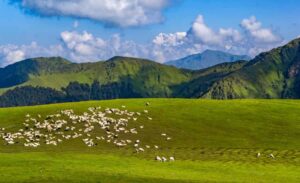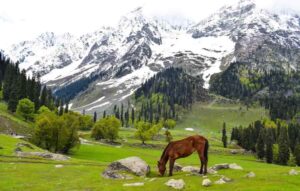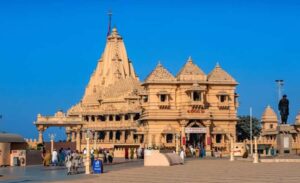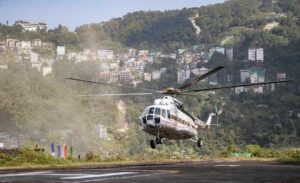Best Time to Visit Badrinath Dham
The holy town of Badrinath, nestled in the Garhwal region of Uttarakhand, India, is one of the most revered pilgrimage sites for Hindus. Dedicated to Lord Vishnu, Badrinath attracts devotees and tourists alike. The town is not just known for its spiritual significance but also for its breathtaking natural beauty. However, planning a visit to Badrinath requires careful consideration of the weather, temperature, and season to ensure a comfortable and enjoyable experience.
The best time to visit Badrinath is during the summer months of May to June and the autumn months of September to October. In this comprehensive guide, we will explore the best time to visit Badrinath, detailing the climatic conditions during different seasons.
Summer (May to June): During these months, the weather is relatively pleasant, with daytime temperatures ranging from 10 to 20 degrees Celsius (50 to 68 degrees Fahrenheit). The snow starts melting, and the roads to Badrinath are usually open for pilgrims. This is the primary pilgrimage season, and you can participate in religious ceremonies and rituals.
Autumn (September to October): This is another favorable time to visit Badrinath. The weather is cool, and the monsoon rains have subsided. The temperature ranges from 5 to 15 degrees Celsius (41 to 59 degrees Fahrenheit). The surrounding landscapes are breathtaking with the changing colors of the foliage, adding to the overall charm of the region.

1. Summer (May to June)
- Temperature: Summer is considered the most favorable time to visit Badrinath. During the daytime, the temperature ranges from 7°C to 18°C, providing a pleasant and comfortable climate for visitors.
- Weather: The weather during summer is generally clear, with minimal chances of rainfall. This period offers excellent visibility of the surrounding snow-capped peaks and the Neelkanth Peak, making it an ideal time for sightseeing and photography.
- Activities: Pilgrims and tourists can comfortably explore the temples and nearby attractions without facing extreme weather conditions.
- dventure enthusiasts can also undertake trekking and other outdoor activities.
2. Monsoon (July to September)
- Temperature: The monsoon season in Badrinath witnesses temperatures ranging from 15°C to 20°C during the day. However, nights can be colder, with temperatures dropping to around 5°C.
- Weather: Monsoon brings moderate to heavy rainfall to the region. Landslides and roadblocks are common during this time, making travel to Badrinath challenging. Pilgrims are advised to exercise caution and stay updated on weather conditions before planning their visit.
- Activities: While the lush greenery and the rain-washed landscapes add a unique charm to Badrinath, outdoor activities may be restricted due to the rain. Pilgrims often find this season less crowded, allowing for a more peaceful worship experience.
3. Autumn (October to November)
- Temperature: Autumn marks the onset of colder temperatures in Badrinath. Daytime temperatures range from 5°C to 15°C, while nights can be extremely cold, with temperatures dropping to 0°C and below.
- Weather: The weather is generally clear, and the skies are crisp, offering stunning views of the Himalayan peaks. This period is considered one of the best times to visit Badrinath for those who can withstand the cold weather.
- Activities: Pilgrims and tourists can enjoy the serene atmosphere and engage in religious ceremonies. It is advisable to carry warm clothing as the temperatures can be quite chilly, especially during the night.
4. Winter (December to April)
- Temperature: Winter is the coldest season in Badrinath, with daytime temperatures ranging from -5°C to 5°C. Nights can be extremely harsh, with temperatures dropping to as low as -15°C or even lower.
- Weather: The region experiences heavy snowfall, transforming Badrinath into a winter wonderland. The town is usually inaccessible during this time, and the temples are closed for worship. Only the idols are shifted to nearby places for the winter season.
- Activities: Winter is not recommended for tourism in Badrinath due to the extreme cold and snow-covered landscapes. However, for those seeking a unique experience, the snow-clad town can be a mesmerizing sight.
Tips for Planning Your Visit
- Check Weather Forecasts: Given the unpredictable nature of the weather, especially during the monsoon season, it’s crucial to check weather forecasts before planning your trip.
- Pack Accordingly: Regardless of the season, it’s advisable to pack layers of clothing. Even in summer, nights can be cool, and in winter, the temperatures are frigid.
- Book Accommodations in Advance: Badrinath attracts a large number of pilgrims, especially during peak seasons. To ensure a comfortable stay, it’s recommended to book accommodations well in advance.
- Respect Local Customs: Badrinath is a sacred pilgrimage site, and visitors are expected to respect the local customs and traditions. Dress modestly and adhere to the guidelines provided by the temple authorities.
- Stay Informed about Road Conditions: Road conditions to Badrinath can be challenging, especially during the monsoon season. Stay informed about road closures and plan your travel accordingly.
In conclusion, the best time to visit Badrinath largely depends on personal preferences and tolerance to weather conditions. Summer and autumn are generally considered the most favorable seasons for a pilgrimage or a leisurely visit. However, each season offers a unique experience, and visitors should plan their trip based on their interests and the kind of atmosphere they seek in this spiritually significant and naturally enchanting destination.
Must Read:





